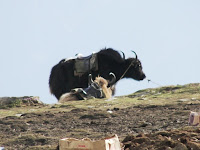Our third and final day of driving to Ladakh early. We left our hotel in Keylong at 4:00 am so that we'd be able to get to Leh while it was still light out. Unfortunately, our first few pictures were completely useless because it was too dark to see anything. After a bit of driving, though, we came across a herd of goats and sheep being led down the road. They got out of the way so that we could pass by.

The picture below shows one interesting aspect of traveling the Leh-Manali Highway. At several spots along the way, we were required to submit our passports for inspection. Most of these inspection points consisted of tents with one police officer checking passports and one or two police officers sleeping on cots nearby (usually under several heavy blankets to stay warm).

The rest of the trip was characterized by amazing scenery that changed markedly as we passed through Rohtang Pass (13,051 feet), Baralachala (the very snowy one shown below at 16,040 feet), and Taglangla (17,582 feet) which is purported to be the second highest motorable pass in the world. Parenthetical captions will have to suffice or this post will become far too long for our readers.


(These were some of the fantastic views on the way to Baralachala.)


(Baralachala displayed some huge walls of snow and a stuck truck.)


(These great landforms changed around every turn.)


(The views were great around every turn, as.)


(The valleys had lots of great landforms and we even drove through a random sandy, desert valley along the way.)


(The last part of the road up to Taglangla was amazing.)

(This sign was good for a laugh.)


(More interesting landforms along the way.)


(The beginnings of Buddhist landmarks in Ladakh.)
The last two pictures show a Buddhist stupa (which is actually called a chorten in Ladakhi) and a small Buddhist monastery on a hill. The state of Jammu and Kashmir is the home of the district of Ladakh. Some will know the name Kashmir as a place plagued by sectarian violence. The state is divided along religious lines to a large extent. Kashmir is predominantly Muslim, Jammu is mostly Hindu, and Ladakh has a majority population of Tibetan Buddhists. This has helped to spare it from the problems of Kashmir. It has also left the landscape covered with monuments to Buddhism such as these.
Now that we've arrived in Leh, the capital of Ladakh, we look forward to exploring and relaxing.
Dave and Beth

BoveNet and the BoveNet blog are published by David and Beth Boven and are licensed under a Creative Commons Attribution-Noncommercial-Share Alike 3.0 United States License.






















































